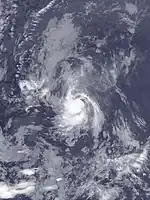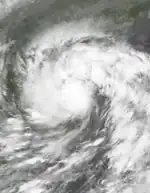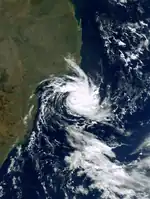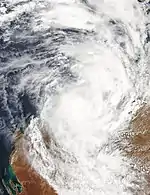The list of unnamed tropical cyclones since naming began includes all tropical cyclones that met the criteria for naming in a basin, but that for whatever reason, did not receive a name. These systems have occurred in all basins and for various reasons.
Scope, reasons, and naming overview

Naming has been used since the 1950 season. In order to ease communications and advisories,[1] tropical cyclones are named when, according to the appropriate Regional Specialized Meteorological Center or Tropical Cyclone Warning Center, it has reached tropical storm status. A tropical cyclone with winds of tropical storm intensity or higher goes unnamed when operationally, it is not considered to have met the criteria for naming. Reasons for this include:
- Being missed during a season, usually because of uncertainties in classification in real time. An example of this is the Azores subtropical storm from the 2005 Atlantic hurricane season.[2]
- Disagreements between warning centre and naming centres over intensity of a cyclone. An example of this is Tropical Storm 06W from the 1995 Pacific typhoon season.[3]
- Formation of a cyclone in an area where no official agency is responsible for naming. An example of this is Tropical Cyclone 29P from the 1996–97 South Pacific cyclone season.[4][5]
- Intentionally left unnamed to avoid confusion. An example of this is the Perfect Storm from the 1991 Atlantic hurricane season.[6]
- Post-operational upgrading. An example of this is Tropical Storm One-E from the 1996 Pacific hurricane season.[7]
North Atlantic Ocean
Only unnamed subtropical cyclones that could have been named are included. This excludes several that existed, but that were unnamed because subtropical cyclones were not named when they existed.
| Storm | Year | Peak classification |
|---|---|---|
| Twelve | 1950 | Tropical storm |
| Fifteen | 1950 | Tropical storm |
| Sixteen | 1950 | Tropical storm |
| One | 1951 | Tropical storm |
| Twelve | 1951 | Category 1 hurricane |
| "Groundhog Day" | 1952 | Tropical storm |
| Three | 1952 | Tropical storm |
| Five | 1952 | Tropical storm |
| Eight | 1952 | Tropical storm |
| Eleven | 1952 | Tropical storm |
| Two | 1953 | Tropical storm |
| Five | 1953 | Tropical storm |
| Eight | 1953 | Tropical storm |
| Eleven | 1953 | Tropical storm |
| Thirteen | 1953 | Tropical storm |
| One | 1954 | Tropical storm |
| Two | 1954 | Tropical storm |
| Four | 1954 | Tropical storm |
| Nine | 1954 | Tropical storm |
| Eleven | 1954 | Tropical storm |
| Thirteen | 1954 | Category 2 hurricane |
| Fifteen | 1954 | Tropical storm |
| Five | 1955 | Tropical storm |
| Eleven | 1955 | Tropical storm |
| Twelve | 1955 | Tropical storm |
| One | 1956 | Tropical storm |
| Two | 1956 | Tropical storm |
| Nine | 1956 | Tropical storm |
| Ten | 1956 | Tropical storm |
| Twelve | 1956 | Tropical storm |
| One | 1957 | Tropical storm |
| Eight | 1957 | Tropical storm |
| One | 1958 | Tropical storm |
| Twelve | 1958 | Tropical storm |
| Storm | Year | Peak classification |
|---|---|---|
| "Escuminac" | 1959 | Category 1 hurricane |
| Six | 1959 | Tropical storm |
| Eight | 1959 | Tropical storm |
| Nine | 1959 | Tropical storm |
| "Texas" | 1960 | Tropical storm |
| Six | 1960 | Tropical storm |
| Six | 1961 | Tropical storm |
| Twelve | 1961 | Tropical storm |
| One | 1962 | Tropical storm |
| Ten | 1962 | Category 1 hurricane |
| One | 1963 | Tropical storm |
| Four | 1963 | Category 1 hurricane |
| One | 1964 | Tropical storm |
| Two | 1964 | Tropical storm |
| Three | 1964 | Category 1 hurricane |
| Thirteen | 1964 | Tropical storm |
| One | 1965 | Tropical storm |
| Four | 1965 | Tropical storm |
| Seven | 1965 | Tropical storm |
| Nine | 1965 | Tropical storm |
| Ten | 1965 | Tropical storm |
| Two | 1966 | Tropical storm |
| Fourteen | 1966 | Tropical storm |
| Fifteen | 1966 | Tropical storm |
| One | 1967 | Tropical storm |
| Two | 1967 | Tropical storm |
| Four | 1967 | Tropical storm |
| Eight | 1967 | Tropical storm |
| Twelve | 1967 | Tropical storm |
| Five | 1968 | Tropical storm |
| Ten | 1969 | Category 1 hurricane |
| Eleven | 1969 | Tropical storm |
| Sixteen | 1969 | Tropical storm |
| Seventeen | 1969 | Category 1 hurricane |
| Storm | Year | Peak classification |
|---|---|---|
| Eight | 1970 | Category 1 hurricane |
| Ten | 1970 | Tropical storm |
| Twenty-One | 1970 | Tropical storm |
| "Caribbean–Azores" | 1970 | Category 1 hurricane |
| "Canada" | 1970 | Category 2 hurricane |
| Nineteen | 1970 | Category 2 hurricane |
| Twenty-Three | 1970 | Tropical storm |
| Two | 1971 | Category 1 hurricane |
| "Gulf Coast" | 1987 | Tropical storm |
| Unnamed | 1988 | Tropical storm |
| "Perfect Storm"[nb 1] | 1991 | Category 1 hurricane |
| Unnamed[nb 2] | 1997 | Subtropical storm |
| Unnamed[nb 2] | 2000 | Subtropical storm |
| "Azores" | 2005 | Subtropical storm |
| Unnamed | 2006 | Tropical storm |
| Unnamed[nb 3] | 2011 | Tropical storm |
| Unnamed | 2013 | Subtropical storm |
| Unnamed | 2023 | Subtropical storm |
South Atlantic Ocean
The South Atlantic is not officially classified as a tropical cyclone basin by the World Meteorological Organization and does not have a designated regional specialized meteorological center (RSMC) that gives official names to tropical cyclones. Despite this, in 2011, the Hydrographic Center of the Brazilian Navy began giving unofficial names to tropical and subtropical cyclones in the south Atlantic. Prior to that, a few systems in the south Atlantic were given names.
There has been one system, Tropical Storm 01Q in 2021, that was monitored and designated 01Q by the National Oceanic and Atmospheric Administration (NOAA). However, the Brazilian Navy did not recognize the system as a tropical cyclone and it remains unnamed.
Eastern and Central North Pacific Ocean

Naming began in 1960. Before 1960, a few systems in the central Pacific basin were given names, generally in an ad hoc manner.
| Storm | Year | Peak classification |
|---|---|---|
| Four[nb 4] | 1962 | Tropical storm |
| Hurricane "C" | 1962 | Unknown |
| Tropical Storm "R" | 1962 | Tropical storm |
| Tropical Storm "T" | 1962 | Tropical storm |
| Tropical Storm "X" | 1962 | Tropical storm |
| Tropical Storm "Z" | 1962 | Tropical storm |
| Tropical Storm "A" | 1962 | Tropical storm |
| Seven[nb 5] | 1962 | Tropical storm |
| Four[nb 6] | 1963 | Tropical storm |
| "Pacific Northwest" | 1975 | Category 1 hurricane |
| Unnamed[nb 7] | 1996 | Tropical storm |
| Unnamed[nb 8] | 2020 | Tropical storm |
Western North Pacific Ocean

The official practice of tropical cyclone naming started in 1945 within the western north Pacific.[14][15] Due to differences in wind speed criteria between the Japan Meteorological Agency and the Joint Typhoon Warning Center, a system will sometimes be considered a tropical storm by the JTWC but only a depression by the JMA, or vice versa. This results in several apparent unnamed systems. Prior to 2000, the JTWC was responsible for tropical cyclone naming, with the JMA assuming responsibility for naming from 2000 and beyond. Due to this, unnamed cyclones that met the JMA's tropical storm criteria but not those of the JTWC prior to 2000 are excluded. Likewise, systems that met the JTWC's tropical storm criteria but not those of the JMA from 2000 to present are also excluded.
| Storm | Year | Peak classification |
|---|---|---|
| Tropical Storm 24W | 1948 | Tropical storm |
| Tropical Storm 26W | 1948 | Tropical storm |
| Tropical Storm 02W | 1950 | Tropical storm |
| Tropical Storm 12W | 1952 | Tropical storm |
| Tropical Storm 14W | 1952 | Tropical storm |
| Tropical Storm 04W | 1953 | Tropical storm |
| Tropical Storm 09W | 1953 | Tropical storm |
| Tropical Storm 13W | 1953 | Tropical storm |
| Tropical Storm 16W | 1953 | Tropical storm |
| Tropical Storm 22W | 1953 | Tropical storm |
| Tropical Storm 23W | 1953 | Tropical storm |
| Tropical Storm 01W | 1954 | Tropical storm |
| Tropical Storm 07W | 1954 | Tropical storm |
| Tropical Storm 08W | 1954 | Tropical storm |
| Tropical Storm 15W | 1954 | Tropical storm |
| Storm | Year | Peak classification |
|---|---|---|
| Tropical Storm 09W | 1955 | Tropical storm |
| Tropical Storm 17W | 1955 | Tropical storm |
| Tropical Storm 20W | 1955 | Tropical storm |
| Tropical Storm 02W | 1956 | Tropical storm |
| Tropical Storm 04W | 1956 | Tropical storm |
| Tropical Storm 08W | 1956 | Tropical storm |
| Tropical Storm 18W | 1956 | Tropical storm |
| Tropical Storm 01W | 1957 | Tropical storm |
| Tropical Storm 08W | 1957 | Tropical storm |
| Tropical Storm 17W | 1957 | Tropical storm |
| Tropical Storm 06W | 1995 | Tropical storm |
| Tropical Storm 24W[nb 9] | 1996 | Tropical storm |
| Tropical Storm 35W | 1996 | Tropical storm |
| Tropical Storm 38W | 1996 | Tropical storm |
| Tropical Storm 03W | 1998 | Tropical storm |
North Indian Ocean
Due to differences in wind speed criteria between the India Meteorological Department and the Joint Typhoon Warning Center, a system will sometimes be considered a tropical storm by the JTWC but only a depression by the IMD. This results in several apparent unnamed systems. Because the IMD is responsible for naming, unnamed cyclones that met the JTWC's tropical storm criteria but not those of the IMD are excluded.
Naming has taken place since mid-2003.
There have been no unnamed tropical cyclones using the India Meteorological Department's criteria. One system, 2007's Yemyin, was upgraded after the fact and retroactively named.[16]
South-West Indian Ocean

Tropical cyclones have been named within this basin since 1960, with any tropical or subtropical depressions that RSMC La Réunion analyze as having 10-minute sustained windspeeds of at least 65 km/h, 40 mph being named. However, unlike other basins RSMC La Réunion does not name tropical depressions, as they delegate the rights to name tropical cyclones to the subregional tropical cyclone warning centers in Mauritius or Madagascar depending on whether the system is located east or west of the 55th meridian east.
| Storm | Year | Peak classification |
|---|---|---|
| Moderate Tropical Storm F1 | 1998–99 | Moderate tropical storm |
| Subtropical Depression 13 | 1999–2000 | Subtropical depression |
| Moderate Tropical Storm 10 | 2000–01 | Moderate tropical storm |
| Subtropical Depression 11 | 2000–01 | Subtropical depression |
| Subtropical Depression 15 | 2006–07 | Subtropical depression |
| Tropical Cyclone 01U | 2007–08 | Category 1 tropical cyclone |
| Subtropical Depression 10 | 2009–10 | Subtropical depression |
| Subtropical Depression 09 | 2010–11 | Subtropical depression |
| Subtropical Depression 13 | 2013–14 | Subtropical depression |
| Moderate Tropical Storm 01 | 2018–19 | Moderate tropical storm |
| Moderate Tropical Storm 08 | 2021–22 | Moderate tropical storm |
| Moderate Tropical Storm 09 | 2022–23 | Moderate tropical storm |
Australian region

| Storm | Year | Peak classification |
|---|---|---|
| Five | 1964–65 | Unknown |
| Six | 1964–65 | Unknown |
| Six | 1965–66 | Unknown |
| Nine | 1965–66 | Unknown |
| Two | 1967–68 | Unknown |
| Three | 1967–68 | Unknown |
| Eleven | 1967–68 | Unknown |
| Thirteen | 1967–68 | Unknown |
| Seventeen | 1967–68 | Unknown |
| Fifteen | 1968–69 | Unknown |
| Sixteen | 1968–69 | Unknown |
| One | 1969–70 | Unknown |
| Seven | 1969–70 | Unknown |
| Storm | Year | Peak classification |
|---|---|---|
| "Flores"[17] | 1972–73 | Category 3 severe tropical cyclone |
| Tropical Cyclone 04U | 1981–82 | Category 1 tropical cyclone |
| Tropical Cyclone 06U | 1983–84 | Category 1 tropical cyclone |
| Tropical Cyclone 01U | 2002–03 | Category 2 tropical cyclone |
| Tropical Cyclone 01U[18] | 2007–08 | Category 1 tropical cyclone |
| Tropical Cyclone 25U[19] | 2010–11 | Category 1 tropical cyclone |
| Tropical Cyclone 22U[20] | 2016–17 | Category 2 tropical cyclone |
| Tropical Cyclone 01U | 2022–23 | Category 1 tropical cyclone |
South Pacific Ocean

| Storm | Year | Peak classification |
|---|---|---|
| One | 1971–72 | Category 1 tropical cyclone |
| Six | 1971–72 | Category 1 tropical cyclone |
| One | 1973–74 | Category 1 tropical cyclone |
| Five | 1976–77 | Category 1 tropical cyclone |
| Six | 1976–77 | Category 1 tropical cyclone |
| Five | 1980–81 | Category 2 tropical cyclone |
| Seven | 1980–81 | Category 1 tropical cyclone |
| Four | 1983–84 | Category 1 tropical cyclone |
| Six | 1983–84 | Category 1 tropical cyclone |
| One | 1984–85 | Category 1 tropical cyclone |
| Tropical Cyclone 19P | 1986–87 | Category 2 tropical cyclone |
| Two | 1990–91 | Category 1 tropical cyclone |
| Tropical Cyclone 29P[nb 10] | 1996–97 | Category 2 tropical cyclone |
Notes
- ↑ Was deliberately left unnamed to avoid any confusion as the news media was focused on the Perfect Storm and was expected to be short-lived and primarily of concern to maritime interests.[6]
- 1 2 Subtropical storms were not given names prior to 2002. However, since this system was recognized post-operationally it is included in this list.
- ↑ Advisories were not issued on this system during August/September 2011 because of the intermittent nature of the convection and the somewhat frontal nature of the satellite presentation.[8]
- ↑ This system was upgraded from a tropical depression to a tropical storm after a letter from a ship called the Golden State prompted a re evaluation of the system.[9]
- ↑ This system was upgraded from a tropical depression to a tropical storm after a ship called the Richfield reported sustained winds of 115 km/h (70 mph).[9]
- ↑ This system was not named or numbered as a tropical cyclone operationally, but has been recognized as an unnamed tropical storm since.[10][11]
- ↑ Was upgraded from a tropical depression to a tropical storm after the United States Coast Guard relayed ship reports to the National Hurricane Center, that suggested the cyclone was a tropical storm.[12]
- ↑ Was upgraded from a tropical depression to a tropical storm after European Space Agency's Advanced Scatterometer (ASCAT) suggested that the cyclone was a tropical storm.[13]
- ↑ Was operationally classified as a depression by both the JTWC and PAGASA, the latter of which named the system Ningning. However, it was later determined by JTWC that the system reached tropical storm intensity.
- ↑ Could not be named during February 1997 as it had developed into a tropical cyclone within the subtropic region of the Southern Pacific.[4][5]
References
Unless otherwise indicated, all storms come from the following datasets from the Regional Specialized Meteorological Center:
- Atlantic: [21]
- Western north Pacific: "RSMC Best Track Data (Text)". Japan Meteorological Agency. Archived from the original on 2013-06-25. Retrieved 2008-06-21.
- Northern Indian, western north Pacific, Southern Hemisphere: "JTWC Tropical Cyclone Best Track Data Site". Joint Typhoon Warning Center. 2007-08-09. Retrieved 2008-05-21.
- Southwestern Indian Ocean: "Untitled". Météo-France. Archived from the original on 2008-04-21. Retrieved 2008-06-21.
- ↑ Christopher Landsea. "Subject: B1) How are tropical cyclones named?" (FAQ). Retrieved 2008-05-05.
- ↑ Jack Beven & Eric S. Blake (2006-04-10). "Unnamed Subtropical Storm" (PDF). National Hurricane Center. p. 1. Retrieved 2008-05-05.
- ↑ "1995 Annual Tropical Cyclone Report" (PDF). Joint Typhoon Warning Center.
- 1 2 RSMC Nadi — Tropical Cyclone Centre; TCWC Brisbane; TCWC Wellington (May 22, 2009). "RSMC Nadi — Tropical Cyclone Centre Best Track Data for 1996/97 Cyclone Season". Fiji Meteorological Service, Meteorological Service of New Zealand Limited, Australian Bureau of Meteorology. United States: International Best Track Archive for Climate Stewardship. Retrieved January 31, 2013.
- 1 2 "Matt Megan's World". The Manawatu Standard. Palmerston North, New Zealand. April 2, 1997. p. 3. – via Lexis Nexis (subscription required)
- 1 2 "The Perfect Storm October 1991" (PDF). National Climatic Data Center. 2008-08-20. p. 1. Retrieved 2011-12-03.
- ↑ Edward Rappaport (1996-11-07). "unnamed tropical storm (formerly Tropical Depression One-E)". National Hurricane Center. Archived from the original on 2008-06-01. Retrieved 2008-05-05.
- ↑ Blake, Eric S; Kimberlain, Todd B; National Hurricane Center (December 2, 2011). Unnamed Tropical Storm: September 1 - 2, 2011 (PDF) (Tropical Cyclone Report). United States National Oceanic and Atmospheric Administration's National Weather Service. p. 2. Archived (PDF) from the original on August 5, 2013. Retrieved August 5, 2013.
- 1 2 Benkman, Walter E (1963). Rosendal, Hans E (ed.). Tropical Cyclones in the Eastern North Pacific, 1962 (Mariners Weather Log: Volume 7 Issue 2: March 1963). United States National Oceanic and Atmospheric Administration. pp. 46–49. ISSN 0025-3367. OCLC 648466886.
- ↑ Shaw Samuel; Central Pacific Hurricane Center. A History of Tropical Cyclones In the Central North Pacific and the Hawaiian Islands 1832-1979. United States National Oceanic and Atmospheric Administration's National Weather Service. Retrieved August 6, 2013.
- ↑ National Hurricane Center; Hurricane Research Division; Central Pacific Hurricane Center (April 4, 2023). "The Northeast and North Central Pacific hurricane database 1949–2022". United States National Oceanic and Atmospheric Administration's National Weather Service. A guide on how to read the database is available here.
 This article incorporates text from this source, which is in the public domain.
This article incorporates text from this source, which is in the public domain. - ↑ Rappaport, Edward N; National Hurricane Center (November 7, 1996). Unnamed Tropical Storm, (formerly Tropical Depression One-E): May 13 - 16 1996 (PDF) (Tropical Cyclone Report). United States National Oceanic and Atmospheric Administration's National Weather Service. Archived from the original on October 5, 2013. Retrieved August 5, 2013.
- ↑ Brown, Daniel P; National Hurricane Center (December 8, 2020). Unnamed Tropical Storm, (formerly Tropical Depression Seven-E): July 20 - 21 2020 (PDF) (Tropical Cyclone Report). United States National Oceanic and Atmospheric Administration's National Weather Service. Retrieved December 11, 2020.
- ↑ Landsea, Christopher W; Dorst, Neal M (June 1, 2014). "Subject: Tropical Cyclone Names: B1) How are tropical cyclones named?". Tropical Cyclone Frequently Asked Question. United States National Oceanic and Atmospheric Administration's Hurricane Research Division. Archived from the original on March 29, 2015. Retrieved May 19, 2017.
- ↑ Cry, George (July 1958). Bristow, Gerald C (ed.). "Naming hurricanes and typhoons". Mariners Weather Log. 2 (4): 109. hdl:2027/uc1.b3876059. ISSN 0025-3367. OCLC 648466886.
- ↑ "Mid-Season Review". India Meteorological Department. Archived from the original on August 8, 2007. Retrieved 2008-05-05.
- ↑ Gary Padgett (2002-04-20). "Monthly Global Tropical Cyclone Summary December 2001". Retrieved 2007-10-21.
- ↑ "Australian Tropical Cyclone Database" (CSV). Australian Bureau of Meteorology. 2023-06-30. Retrieved 2023-06-30. A guide on how to read the database is available here.
- ↑ Courtney, Joe. Unnamed Tropical Cyclone (25U) (PDF) (Report). Australian Bureau of Meteorology. Retrieved 19 April 2022.
- ↑ "Tropical Cyclone 22U". Australian Bureau of Meteorology. April 28, 2017. Retrieved April 28, 2017.
- ↑ "Atlantic hurricane best track (HURDAT version 2)" (Database). United States National Hurricane Center. April 5, 2023. Retrieved January 14, 2024.
 This article incorporates text from this source, which is in the public domain.
This article incorporates text from this source, which is in the public domain.